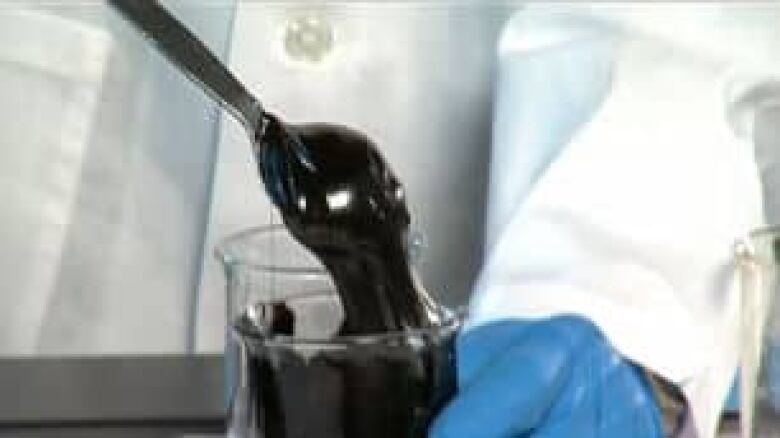Taking steam out of the oilsands
Calgary company wins an endorsement for its new process
A new technology being developed by a Calgary company could address one of the biggest problems of the oilsands:high water usage.
Petrobank Energy and Resources' process recentlypassed a significant hurdle, validating a technologyits backers say will not only get out more oil, but also have a smallerenvironmental footprint.

Last week, independent engineering consultants McDaniel & Associates, in the first comprehensive evaluation of the technology, concluded that Petrobank is, in its words, "successfully proving" Toe to Heel Air Injection (THAI).
"It tells industry that the technology is commercially viable," Chris Bloomer, Petrobank's chief operating officer, told CBC News.
UBS analyst Matt Donohue agreed, saying in a commentary that the report "validated the technology as an effective recovery process."
The most widely seen view of the oilsands is of huge trucks and shovels mining the 20 per cent of bitumen that is near the surface. This new process targets in-situ bitumen, which istoo deep to be mined andmakes up 80 per cent of Canada's oilsandsreserves.
The mainstay technology now usedfor in-situ bitumen is Steam-Assisted Gravity Drainage or SAGD which uses steam to heat the bitumen so it flows downward into wellsand can bepumped to the surface.
SAGD uses one barrel of water for every four barrels of oil produced, although most of that is recycled. The THAI process requires minimal water and natural gas, haslower production and capital costs,takes up less surface area and produces lower greenhouse gas emissions.
Petrobank's work on THAI goes back nine years. It has been conductingfield testsat its Whitesandsprojectnear Conklin, Alta., south of Fort McMurray, since 2006.
As shown in the diagram, THAIuses combustion, fueled byair injected down wells, deep in the reservoir. The air is also used to steer the combustion front fromthe "toe" of the reservoir (on the left side) to the "heel" (on the right)to melt bitumen so it will flow to the surface.

The heatalso partially refines the oil by removing sulphur while still underground.
The McDaniel evaluation of the Whitesands operationestimatedthat THAI will produce 259 million barrels, or 17 per cent, more oil than had SAGD been used.
The report also found THAI worked in a bigger part of the reservoir, and Bloomer said that has implications in terms of how much more oil could be produced from the entire oilsands.
"(SAGD) only [works] in the very, very best, thickest, part of the oilsands reservoir probably five per cent of the potential resource," he said. "If you look at the [difference using THAI over SAGD], it could be hundreds of millions of barrels more oil to be recovered than competing technologies."
Petrobank is only one company developing alternative ways to exploit the oilsands.
Calgary-based E-T Energy is working on using giant electrodes to heat underground formations. Another Calgary firm N-Solv Corporation is developing a process toinject heated solvent vapour and stimulate oil flow.Petrobank's technology, however,is the first to be evaluated in the field for its capacity to increase recovery.
The next step for THAI will bea further study by McDaniel to get a more precise production estimate once Petrobank reaches commercial flow rates greater than 250 barrels a day and sustains that for at least three months.
"We're close to that now," said Bloomer.

"As (Petrobank) intensifies its efforts to sustain commercial production rates, said UBS analyst Donohue, "We expect the company to reap the rewards."
The potential for THAI extends well beyond the oilsands, including increasing production from heavy oil deposits further south in Alberta and Saskatchewan.
"There's probably another 20 billion barrels of oil that isn't recoverable using current technology that we can apply our technology to," said Bloomer.
Worldwide, it'sestimated thereare reserves of about 8.9 trillion barrels in bitumen and heavy oil depositsinColumbia, Venezuela, Russia, China, India and Madagascar. Much of it can't be economically recovered using current technologies.
"The world is not running out of oil," Bloomer said. "It's running out of light oil."
For Bloomer, the McDaniel report was the validation of years of effort and a rebuttal to the skeptics who questioned whether the technical obstacles could ever be overcome.
"When we first started this, people said, 'Aw, you're never going get combustion in the reservoir, you're never going to produce, you're going to burn up the well, you're going to produce acid solutions, the oil won't be saleable,'" he recalled.
Petrobank's employeesconfronted those concerns, he said, "and we've just keep knocking them down."












_(720p).jpg)


 OFFICIAL HD MUSIC VIDEO.jpg)
.jpg)



























































































